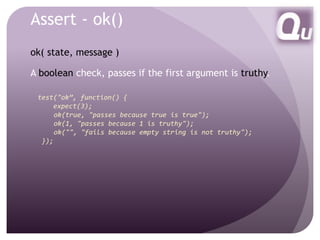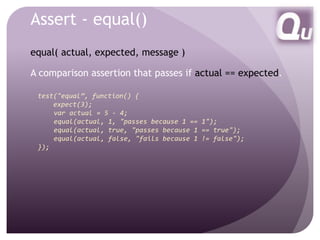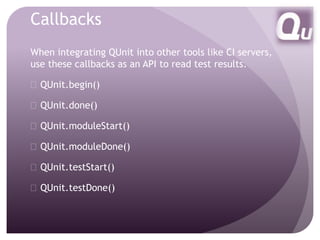Qunit Java script Un
- 1. By : Akanksha Arora
- 2. Points to Discuss ï Unit Testing & Test Driven Development ï QUnit ï QUnit API ï Automated Testing (a brief introduction)
- 3. Unit Testing ï In computer programming, unit testing is a procedure used to validate that individual modules or units of source code are working properly. ï Unit testing is used for (i) Test Driven Development (ii) Fixing bugs (iii) Regression testing
- 4. Test Driven Development ï Test-Driven Development (TDD) is a computer programming technique that involves repeatedly first writing a test case and then implementing only the code necessary to pass the test. ï Test-driven development is a method of designing software, not merely a method of testing.
- 6. Fixing bugs/Regression Testing ï Fixing bugs ï Regression testing
- 7. What do you need? ï A Unit Testing framework ï Development Environment
- 8. QUnit ï QUnit is a powerful, easy-to-use JavaScript unit testing framework. ï It's used by the jQuery, jQuery UI and jQuery Mobile projects and is capable of testing any generic JavaScript code, including itself! ï Supports the same browsers as jQuery 1.x. That's IE6+ and Current - 1 for Chrome, Firefox, Safari and Opera.
- 9. Getting Started ï Just qunit.js, qunit.css, and a little bit of HTML ï A Quick Demo: http://jsfiddle.net/akankshaaro/rq31v84h/
- 10. QUnit API ï Test ï Assert ï Async Control ï Callback
- 11. Test : QUnit.test( name, test ) ï Adds a test to run. ï Testing the most common, synchronous code Qunit.test(âname of the testâ, function() { //write down the assertions }); function: Function to close over assertions
- 12. Test : expect() Specify how many assertions are expected to run within a test. If the number of assertions run does not match the expected count, the test will fail. test(âexpected assertions", function() { expect( 2 ); //two assertions are expected });
- 13. Asserts ï ok ï Equal ï notEqual ï strictEqual ï notStrictEqual ï deepEqual ï notDeepEqual ï throws
- 14. Assert - ok() ok( state, message ) A boolean check, passes if the first argument is truthy. test("okâ, function() { expect(3); ok(true, "passes because true is true"); ok(1, "passes because 1 is truthy"); ok("", "fails because empty string is not truthy"); });
- 15. Assert - equal() equal( actual, expected, message ) A comparison assertion that passes if actual == expected. test("equalâ, function() { expect(3); var actual = 5 - 4; equal(actual, 1, "passes because 1 == 1"); equal(actual, true, "passes because 1 == true"); equal(actual, false, "fails because 1 != false"); });
- 16. Assert - notEqual() notEqual( actual, expected, message ) A comparison assertion that passes if actual != expected. test("notEqualâ, function() { expect(3); var actual = 5 - 4; notEqual(actual, 0, "passes because 1 != 0"); notEqual(actual, false, "passes because 1 != false"); notEqual(actual, true, "fails because 1 == true"); });
- 17. Assert - strictEqual() strictEqual( actual, expected, message ) A comparison assertion that passes if actual === expected. test("notEqualâ, function() { expect(3); var actual = 5 - 4; strictEqual(actual, 1, "passes because 1 === 1"); strictEqual(actual, true, "fails because 1 !== true"); strictEqual(actual, false, "fails because 1 !== false"); });
- 18. Assert - notStrictEqual() notStrictEqual( actual, expected, message ) A comparison assertion that passes if actual !== expected. test("notStrictEqualâ, function() { expect(3); var actual = 5 - 4; notStrictEqual(actual, 1, "fails because 1 === 1"); notStrictEqual(actual, true, "passes because 1 !== true"); notStrictEqual(actual, false, "passes because 1 !== false"); });
- 19. Assert - deepEqual () deepEqual( actual, expected, message ) Recursive comparison assertion, working on primitives, arrays and objects, using ===. test("deepEqualâ, function() { expect(3); var actual = {a: 1}; equal( actual, {a: 1}, "fails because objects are different"); deepEqual(actual, {a: 1}, "passes because objects are equivalent"); deepEqual(actual, {a: "1"}, "fails because '1' !== 1"); });
- 20. Assert - notDeepEqual() notDeepEqual( actual, expected, message ) Recursive comparison assertion. The result of deepEqual, inverted. test("notDeepEqualâ, function() { expect(3); var actual = {a: 1}; notEqual( actual, {a: 1}, "passes because objects are different"); notDeepEqual(actual, {a: 1}, "fails because objects are equivalent"); notDeepEqual(actual, {a: "1"}, "passes because '1' !== 1"); });
- 21. Assert - throws() Assertion to test if a callback throws an exception when run and optionally compare the thrown error. test("throwsâ, function() { expect(3); throws( function() { throw new Error("Look me, I'm an error!"); }, "passes because an error is thrown inside the callbackâ ); throws( function() { x // ReferenceError: x is not defined }, "passes because an error is thrown inside the callbackâ ); throws ( function() { var a = 1; }, "fails because no error is thrown inside the callbackâ ); });
- 22. Tests Should be Atomic ï Execution order cannot be guaranteed! ï Each test should be independent from one another. ï QUnit.test() is used to keep test cases atomic.
- 23. Async Control : QUnit.asyncTest For testing asynchronous code, QUnit.asyncTest will automatically stop the test runner and wait for your code to call QUnit.start() to continue. The following illustrates an asynchronous test that waits 1 second before resuming QUnit.asyncTest( "asynchronous test: one second later!", function( assert ) { expect( 1 ); setTimeout(function() { assert.ok( true, "Passed and ready to resume!" ); QUnit.start(); }, 1000); });
- 24. Async Control : QUnit.stop() Increase the number of QUnit.start() calls the testrunner should wait for before continuing. When your async test has multiple exit points, call QUnit.stop() multiple times or use the increment argument. QUnit.test( "a test", function( assert ){ QUnit.stop(); setTimeout(function(){ assert.equals("somedata" , "someExpectedValue" ); QUnit.start(); }, 150 ); });
- 25. Grouping Tests : QUnit.module() It groups tests together to keep them logically organized and be able to run a specific group of tests on their own. All tests that occur after a call to QUnit.module() will be grouped into that module. The test names will all be preceded by the module name in the test results. QUnit.module( "group a" );//tests for module a QUnit.module( "group b" );//test for module b
- 26. Grouping Tests : QUnit.module() QUnit.module() can also be used to extract common code from tests within that module. The QUnit.module() function takes an optional second parameter to define functions to run before and after each test within the module QUnit.module( "module", { setup: function( assert ) {//any setup task}, teardown: function( assert ) {//task to be performed after test completion} }); QUnit.test( "test with setup and teardown", function() { //test cases });
- 27. Callbacks When integrating QUnit into other tools like CI servers, use these callbacks as an API to read test results. ï QUnit.begin() ï QUnit.done() ï QUnit.moduleStart() ï QUnit.moduleDone() ï QUnit.testStart() ï QUnit.testDone()
- 28. QUnit Test - Suite
- 29. Node :QUnit 1. Install nodejs 2. Install qunit node module npm install qunit testrunner.js var runner = require("../../node/node_modules/qunit"); runner.run({ code : "/full/path/to/public/js/main.js", tests : "/full/path/to/tests/js/tests.js" }); Node command node tests/js/testrunner.js
- 30. Automated Testing Install Node Using Node Package Manager install Grunt Install QUnit module to your project directory(npm install qunit) â project â src // plugin source, project files, etc â tests // we'll be working in here mostly â â lib â â â jquery-1.x.x.min.js // if you need it (QUnit doesn't) â â â qunit-1.10.0.js â â â qunit-1.10.0.css â â index.html // our QUnit test specification â â tests.js // your tests (could be split into multiple files) â Gruntfile.js // you'll create this, we'll get to it shortly â package.json // to specify our project dependencies
- 31. Automated Testing (contd.) //package.json { "name": "projectName", "version": "1.0.0", "devDependencies": { "grunt": "~0.4.1", "grunt-contrib-qunit": ">=0.2.1", } } //Gruntfile.js module.exports = function(grunt) { grunt.initConfig({ pkg: grunt.file.readJSON('package.json'), taskName: {qunit: { all: ['tests/*.html'] }} }); grunt.loadNpmTasks('grunt-contrib-qunit'); grunt.registerTask('default', ['qunit']); };






























![Automated Testing (contd.)
//package.json
{
"name": "projectName",
"version": "1.0.0",
"devDependencies": {
"grunt": "~0.4.1",
"grunt-contrib-qunit": ">=0.2.1",
}
}
//Gruntfile.js
module.exports = function(grunt) {
grunt.initConfig({
pkg: grunt.file.readJSON('package.json'),
taskName: {qunit: {
all: ['tests/*.html']
}}
});
grunt.loadNpmTasks('grunt-contrib-qunit');
grunt.registerTask('default', ['qunit']);
};](https://image.slidesharecdn.com/qunit-140902042040-phpapp02/85/Qunit-Java-script-Un-31-320.jpg)
